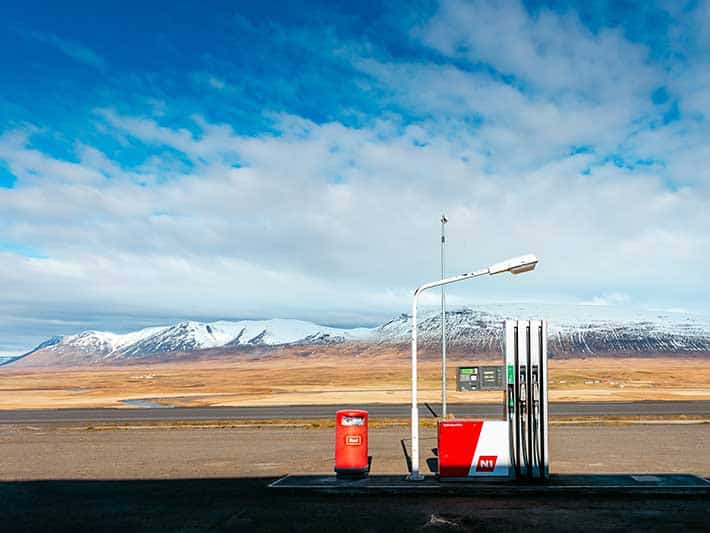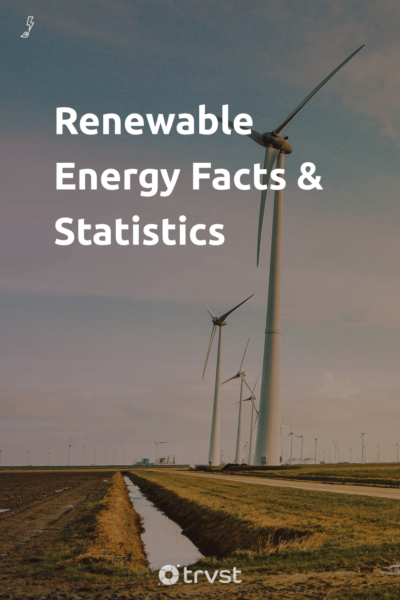39 Renewable Energy Facts & Statistics
Renewable energy sources are energy sources that can never run out. Industry stakeholders' recent renewable energy facts show that global energy reliance on these sources has gained momentum over time. We can mostly attribute these gains in renewable energy consumption to a steady decline in renewable energy prices worldwide.
And, of course, growing concerns as to the pollution and climate impact of non-renewable energy generated from fossil fuels. As a result, many countries are moving to replace non-renewable energy like coal and gas with wind power, solar power, and hydropower.
Here are 39 fascinating renewable energy facts and statistics.
39 Renewable Energy Facts

Global Renewable Energy Generation
#1- At the end of 2019, global generation capacity from renewable sources amounted to 2,537 GW1
#2- Renewable energy makes up 26% of global electricity generation[ref]
#3 - In the UK Renewable Energy now accounts for 47% of total electricity needs (Q1 2020)2
(with fossil fuels and nuclear making up the remainder)
#4- US renewable sources such as wind and solar grew 90% from 2000, resulting in around 20% of total US electricity generation[ref]
Today, States with a fast rate of clean energy adoption usually have a lower demand for fossil fuels. Examples of such states include Iowa and Kansas, which have transitioned to renewable fuels faster.
The International Energy Agency (IEA) reported that solar energy could power half of the world's energy needs by 2050 and lead the charge to alternative energy sources as we leave behind fossil fuels. Solar has massive potential as the sun sends enough solar energy to earth every hour to power the planet for a year.
#5- The US devotes over half of its renewable sources to generating electricity
Renewable energy sources such as solar, wind, and geothermal energy can all generate electricity. Their use has become widespread over the years because they emit little or no carbon to produce the nation's energy.
A Way to Go
#6- There were about 9,719 power plants in the United States that have operational generators with a combined nameplate electricity generation capacity of at least 1 megawatt (MW) as of December 31, 2018[ref]
Recent statistics show that the US is one of the biggest clean energy consumers. However, it still relies heavily on fossil fuels burning power plants.
Today, most power plants burn coal while others are nuclear energy powered. However, the major downside is that both pose serious health risks. Coal plants emit 84 of 187 hazardous air pollutants (which include greenhouse gases) identified by the US Environmental Protection Agency.
On the other hand, nuclear plants do not contribute greenhouse gas emissions, including carbon dioxide (CO2) but come with their own risks. Radiation exposure is among the leading causes of severe health risks. These include cancer and cardiovascular diseases. Additionally, they also reduce the quality of living in a particular area.
Hydro
#7- Hydropower accounted for the largest share of the global total renewable energy generation, with a capacity of 1,190 GW1
#8- The United States is the third-largest producer of hydropower after China and Brazil[ref]
#9- Moving water is the most important renewable energy source in Canada, providing 60per cent of Canada's electricity generation[ref]
#10- The US hydropower industry directly employs 66,448 people—54,870 of whom worked in the traditional hydropower sector, and 11,578 of whom worked in the low-impact hydroelectric subsector[ref]
Hydroelectricity is the most commonly used renewable energy source in most parts of the world. Canada's renewable energy ranks seventh in the world in terms of size. Even though wind power generation has been climbing steadily, hydropower remains Canada's primary source of power consumption.
In 2017, moving water provided 60 percent of Canada's electricity. Or about 49,000 megawatts of the 80,764 megawatts of total renewable electricity generated across the country. (read more about the history of hydro energy and environmental impacts of hydropower)
Growth in Wind Power
#11- From 2001 to 2017, the cumulative wind capacity around the world increased to over 539,000 megawatts from 23,900 MW—over 22 fold[ref]
Further, there's been a steady increase in the number of offshore wind farms used to generate electricity from easily accessible wind energy. The UK is at a greater advantage over the US in the use of wind-based types of renewable energy, including tidal, due to its windier shores.
Meanwhile, many developing countries still rely heavily on natural gas and coal fossil fuels. Of course, these pollute the environment. The best way to minimize our reliance on fossil fuels is that governments should create efficiency standards. And roll out policies that encourage the use of renewable energies.
#12- Wind is now the most used source of energy generation in the US [ref]
#13- Wind accounts for a little over 6 percent of US energy generation. It has become the cheapest energy source in many parts of the country.
There's been so much talk about cutting off the world's reliance on fossil fuels and stepping up efforts to promote clean energy. Renewable sources such as wind and solar power are much cleaner and don't harm our environment compared to fossil fuels. It has one of the lowest global warming potentials, which makes wind energy ideal for electricity and other forms of energy. While, whereas solar energy has both advantages and disadvantages, once installed, solar farms can generate clean electricity for decades without extracting finite resources.
Wind Energy Generation is Developing Fast
#14- The first US offshore wind farm opened in 2016 in Rhode Island
The United States' first attempt at offshore electricity generation was the Rhode Island wind farm, developed by Deepwater Wind. The plant takes advantage of the Atlantic Ocean wind, comprising five turbines, and powers about 17000 homes.
The US government has approved more offshore wind farms since it stepped into the offshore wind farm operation in 2016. In 2019, an 800-megawatts Vineyard Wind project off the coast of Massachusetts kicked off. Massachusetts Governor Charlie Baker was considering 1600 megawatts of wind power in the state by 2027. This move will support over 9,000 jobs over the next seven years and generate a total economic package between $1.4 billion to $2.1 billion in Massachusetts.
#15- A single 2.5MW wind turbine can generate enough electricity to meet the annual needs of over 1,400 households
#16- Siemens built the first-ever commercial offshore wind turbine. Its blades were 5 meters long, producing just 30 kilowatts of power. The latest model, in comparison, has 75 meters blades, producing 6 megawatts (25,000 times as much)–enough to power 6,000 homes[ref]
#17- US onshore wind resources have the potential to generate almost 11,000 GW of electricity, 113 times more than the current installed capacity of 97.2GW3
Elsewhere

#18- In 2018, renewable energy sources accounted for 99 percent of the power generated in Costa Rica, and 97 percent of the electricity produced in Uruguay in the same year4
#19- Renewable energy sources currently provide about 17 percent of Canada's total primary energy supply[ref]
#20- Globally, 32 countries had at least 10 GW of renewable power capacity in 2019, compared to 19 countries a decade earlier
#21- Solar power isn't just a daytime deal—you can store energy from the sun's rays in salt and use it at night too[ref]
#22- US ethanol production is projected to reach 40 million gallons per day in 2050
#23- Roughly 40 percent of the US corn crop was diverted to the production of ethanol for gasoline, up from 20 percent in 2006[ref]
#24- Assuming intermediate efficiency, solar photovoltaic (PV, or solar panels) modules covering 0.6per cent of US land area could meet national electricity demand[ref]
#25- More energy from the sun falls on the earth in one hour than the amount everyone in the world use in a year[ref]
#26- 100 cities worldwide now boast of at least 70per cent renewable energy[ref]
#27- Hydropower and wood were the most used renewable energy resources in the US until the 1990s[ref]
Policy Driving Growth
In the mid-80s, wood and hydropower energy were the bulk of the US energy consumption. Recent statistics show a decline in wood and hydropower use but saw an increase in all the other renewable resources combined. The US renewable energy sources will continue to increase through 2050, says The US Energy Information Administration.
#28- The Energy Policy Act of 2005 created a Renewable Fuel Standard that required 2.78 percent of the gasoline consumed in the United States in 2006 to be renewable fuel[ref]
The motivation behind the Energy Policy Act of 2005 was to improve energy security and environmental quality. The Act mandated a 100per cent increase in the country's use of biofuels.
Although the US government has put in laudable efforts to establish a carbon-free environment, the rate of transformation remains slow. However, in the event your US energy utility does not provide renewable energy, you can purchase Renewable Energy Certificates (RECs) to offset your use. Elsewhere, government policies and financial support will influence these changes to a great extent in different parts of the world.
#29- In 2016, Portugal powered their entire nation for four consecutive days through a combination of wind, solar and hydro-generated electricity. This 107-hour run marked a milestone in Portugal's clean energy run to meet the EU's renewable targets for 2020[ref]
#30- In 2019, Google became the world's largest corporate consumer of renewable power, buying over 2.7GW[ref]
#31- In 2018, about 171 million people had access to electricity through solar PV lighting, solar power home systems, and renewable-based mini-grids[ref]
Environmental Considerations For Renewable Energy

#32- Unlike fossil fuels, non-biomass renewable sources of energy (hydropower, wind, and solar) do not directly emit greenhouse gases
Biomass is generated from wood, municipal solid waste, landfill gas, and crops grown specifically for the purpose and has been described as an alternative to coal. Because, in the process of turning biomass into energy to produce electricity, it emits fewer greenhouse gases than fossil fuels. However, this is not entirely true.
Biomass from forest trees produces higher carbon emissions than those from fossil fuels like coal. Nevertheless, sawdust and chips from sawmills produce less carbon since they decompose quickly. Although this may look promising, it doesn't mean biomass is completely environmentally safe.
Today, it's imperative to embrace non-biomass renewable sources of energy if we intend to go clean. Hydropower, wind, and solar are all renewable sources that deliver zero direct emissions.
Wildlife
#33- Wind turbines generate no emissions. They don't use water when producing electricity, but concerns include bat and bird mortality, land use, noise, and aesthetics[ref]
With the prices for wind energy declining, it has become a valuable resource. From 2001 to 2017, wind energy capacity around the world exploded from 23,900 megawatts to 539,000 megawatts. Which is a remarkable feat. However, growing concerns over wind turbines clashing with birds and bats, killing thousands annually, have labeled it a threat to wildlife.
Apart from these direct clashes, wind turbines also reduce air pressure. As a result, this could lead to Barotrauma in bats, damaging their lungs. The good thing is that engineers are working to build turbines that are safer for flying wildlife. As such, mitigating the worst of wind is one of the fastest-growing renewable energy sources.
Additionally, small wind turbines are being developed for local use and look set to prove beneficial for rural areas that other renewable energy options may serve less well.
#34- While solar PV modules produce no emissions during operation, toxic substances (e.g., cadmium and selenium) are used in their construction[ref]
#35- Wood—primarily as pulp, paper, and paperboard industry waste products—accounts for 46 percent of total biomass energy consumption[ref]
Trends and Forecast
#36- Renewable energy could supply four-fifths of the global demand for electricity by 2050, massively cutting carbon emissions and helping to mitigate climate change and global warming4
#37- Wind and solar energy continue to dominate renewable capacity expansion, jointly accounting for 90 percent of all net renewable additions in 20191
#38- Asia has the fastest-growing renewable energy sector in the world. Renewable energy accounted for 54 percent of new capacity in 2019. An increase in renewable capacity of 95.5 GW to reach 1.12 TW (44 percent of the global total)[ref]
#39- The nation's fastest-growing profession over the next decade is likely to be wind turbine technician[ref]
#40- According to the International Renewable Energy Agency (IRENA), jobs in the renewable energy sector grew from 1.7m in 2004 to 11.5m in 20195

